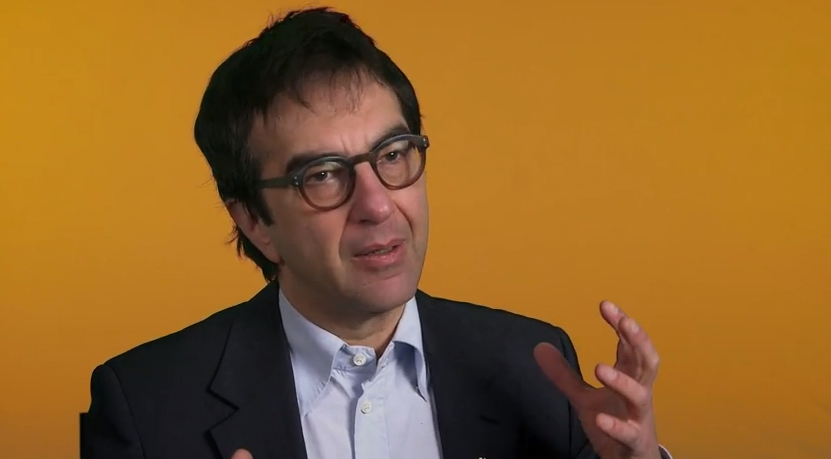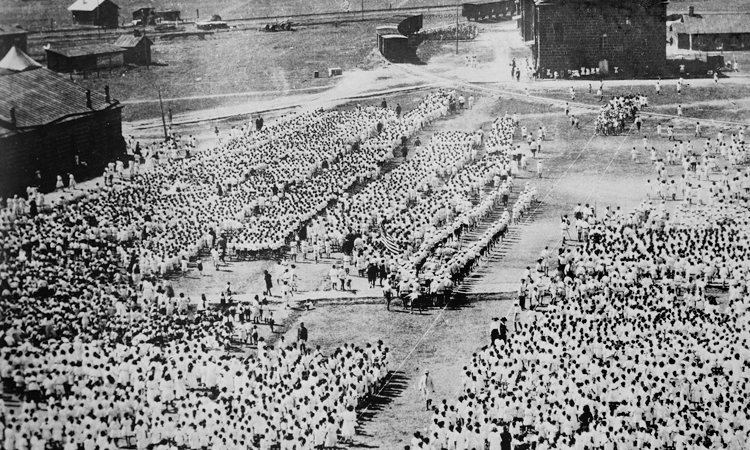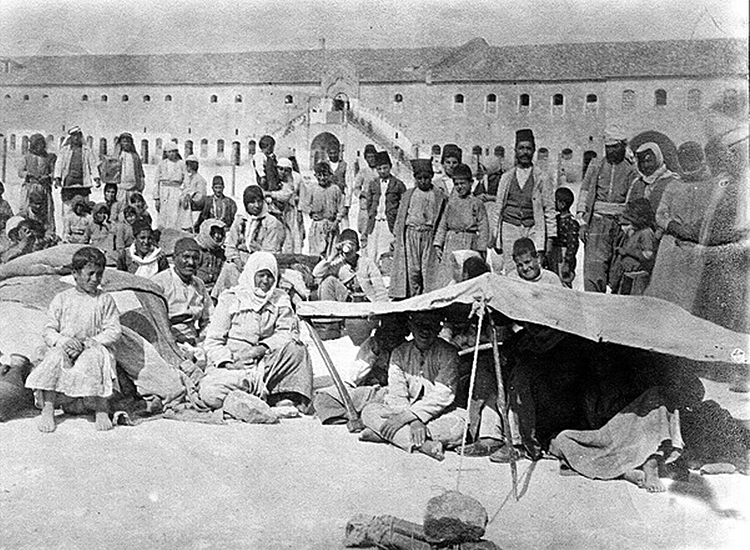Educator Tools

 Ask yourself:
Ask yourself:
- What happens when two historical narratives contradict each other? How do you decide what is true or what to believe?
- Why is gaining recognition so important to the Armenians? Why is the Turkish government, and many other countries, so reluctant to call the events of 1915 genocide?
This chapter explores the controversy surrounding the historiography and recognition of the Armenian genocide. Use the timeline and the primary and secondary sources below to understand the arguments of genocide “believers” and “deniers,” as well as the importance of recognition for the Armenians, and the reluctance of many countries to call the events of 1915 a genocide.
 Definitions
Definitions
Genocide: The deliberate and systematic destruction of an ethnic, racial, caste, religious, or national group.
Historiography: The body of historical writing on a certain subject.
Ottoman Empire (1453-1922): An Islamic empire that stretched from Eastern Europe to North Africa, which was dissolved when modern Turkey was established.
Sublime Porte: The central government in the Ottoman Empire.
Millet System: The Ottoman Empire was organized into millets based on religion. While Muslim millets enjoyed all freedoms, those in Christian millets, such as the Armenians, were seen as second-class citizens and faced a variety of discriminatory policies and practices, including higher taxation.
Hamidiye: A semi-regular regiment of Kurdish and Circassian horsemen organized by Sultan Hamid II to suppress Armenian rebellions in the Ottoman Empire.
The Young Turks: A Turkish reform organization promising to replace the disorder and corruption under the Sultan’s reign with a constitutional government where all Ottoman citizens would be equal.
The Committee of Union and Progress: A branch of the Young Turk organization that assassinated Sultan Hamid II.
The Young Turk Triumvirate: An ultra-nationalist government led by Mehmed Talaat, Ismail Enver, and Ahmed Djemal. Together they took control of the original Young Turk government and promoted Pan-Turkism instead of equality.
Pan-Turkism: An ideology promoting the construction of a Turkish empire stretching from Anatolia into Central Asia whose population would be exclusively Turkic instead of Ottoman.
Turkification: A strategy to destroy non-Turkic cultures through assimilation or removal.
Shotas: Armed groups of men trained and equipped by the Young Turk triumvirate to assist with the round-up of the Armenians and to disrupt the deportation process by looting, raping, and killing Armenians.
Source: The Genocide Education Project, Human Rights and Genocide, 2005.
This really happened
“The aim of war is not to reach definite lines, but to annihilate the enemy physically. After all, who today still speaks of the massacre of the Armenians?”
It was Hitler who said this to his military officers one week before Nazi Germany invaded Poland and brought the world into war for a second time. But what exactly did Hitler mean when referring to the massacre of the Armenians?
As historian Peter Balkian explains, Hitler is recalling what many refer to as “the forgotten genocide” or “hidden holocaust” of the Armenians that began in 1915. The genocide resulted in the deaths of approximately 1.5 million Armenians in the Ottoman Empire and has left many of its survivors scattered worldwide. But wait, you might ask, “wasn’t the Jewish Holocaust the first genocide of the 20th century?” This really depends on whom you ask. The Armenian genocide is one of the most contested genocides in history and is still being debated today—over a century later. However, before we dive deeper into the controversy around the genocide, let’s take a step back and explore the Turkish and Armenian pasts by examining the timeline on the next page. For a more comprehensive timeline visit the following websites:
The Armenian National Institute
The Armenian Genocide Museum
So where does the controversy lie? It lies in two divergent and competing interpretations of the events you just read about in the timeline. Even though both accounts agree that the massacres of the Ottoman Armenians took place, they disagree on the case of whether or not these massacres should be deemed genocide. A summary of the two main interpretations is presented in the table below.
| Genocide believers | Genocide deniers |
|---|---|
| Declare that genocide did occur because the Young Turk Triumvirate conducted the massacres and deportations systematically and with the intention of exterminating the entire Armenian ethnic population. | Proclaim genocide did not occur because the Young Turk Triumvirate was rationally responding to Armenian rebellions, which were supported by the Allied Powers and threatened the dissolution of the entire Ottoman Empire. |
Both views have found a place in separate historical narratives that vow to disprove the other. The former supported by the Armenian population, while the latter, by the Turkish government. Whichever historiography other countries choose to acknowledge determines whether or not they recognize the genocide. Although international recognition for the Armenian genocide is growing, there are still a large number of countries that do not officially recognize the events of 1915 as genocidal. Before we decide how to recognize the genocide, let us first take the time to give the issue a more thorough examination by consulting primary and secondary sources.
Timeline of the Armenian Genocide
| Year | Events in History |
|---|---|
| 1502 |
|
| 1860-1865 |
|
| 1876 |
|
| 1877-1878 |
|
| 1880-1890 |
|
| 1892-1896 |
|
| 1908-1909 |
|
| 1913 |
|
| 1914 |
|
| Under the Young Turk Triumvirate (1913-1918) |
|
| 1915 |
|
| 1918-1919 |
|
| 1920-1923 |
|
Permission granted – Armenian Genocide Museum
Source: The Genocide Education Project, Human Rights and Genocide, 2005 and The Armenian Genocide Museum Institute.
 Artifacts
Artifacts
Artifact One › A cable sent to Washington from the American Ambassador to the Ottoman Empire, July 1915
“Persecution of Armenians assuming unprecedented proportions. Reports from widely scattered districts indicate systematic attempt to uproot peaceful Armenian populations and through arbitrary arrests, terrible tortures, whole-sale expulsions and deportations from one end of the Empire to the other accompanied by frequent instances of rape, pillage, and murder, turning into massacre, to bring destruction and destitution (hardship; poverty) on them. These measures are not in response to popular or fanatical (obsessive) demand but are purely arbitrary and directed from (the Sublime Porte in) Constantinople in the name of military necessity, often in districts where no military operations are likely to take place . . . there seems to be a systematic plan to crush the Armenian race.”
– Henry Morgenthau
Source: Samantha Power, A Problem from Hell: America and the Age of Genocide (New York: Perennial, 2003).
Artifact Two › A Passage from Talaat’s Memoir (assembled after his death in 1921)
“I admit that we deported many Armenians . . . but we never acted in this matter upon a previously prepared scheme. The responsibility for these acts falls first of all upon the deported people themselves. Russia, in order to lay hand on our eastern provinces, has armed and equipped Armenian(s) and organized strong Armenian bandit forces . . . (that began) blowing up the bridges, setting fire to the Turkish towns and villages . . . and endangered the Turkish Army’s line of retreat . . . Every Armenian Church, it was later discovered, was a depot of ammunition. In this disloyal way they killed more than 300,000 (Muslims).
It was impossible to shut our eyes to the treacherous acts of the Armenians, at a time when we were engaged in a war which would determine the fate of our country. Even if these atrocities had occurred in a time of peace, our Government would have been obliged to quell such outbreaks. The (Sublime) Porte . . . wishing to secure the safety of its army and its citizens, took energetic measures to check these uprisings.
These preventative measures were taken in every country during the war, but, while the regrettable results were passed over in silence in the other countries, the echo of our acts was heard all over the world.”
Source: Richard G. Hovannisian, ed., The Armenian Genocide in Perspective (New Brunswick: Transaction, 1986).
Artifact Three › Resistance by Armenians in the Province of Van, April-May, 1915
“Gradually we got news that Turks wanted to finish off all Armenians . . . we had secret meetings to figure out when this was going to happen and how we could prepare to resist and defend ourselves.”
“We children used to go from house to house to gather brass candle bars to make shells for the bullets . . . The Turks had all the ammunition and ours was very limited, so we had to be very careful not to waste any.”
Russian forces came to support the Armenians in Van in late April and the Turks retreated until 1918, when they eventually gained control of the province.
Source: D.E. Miller and L.T. Miller, Survivors: An Oral History of the Armenian Genocide (Los Angeles: University of California Press, 1993).
Artifact Four › Excerpts from the Sublime Porte’s Public Notice of Deportation, 1915
- all Armenians are obliged to leave [except the sick], within five days . . . under [police] escort.
- they are free to carry with them . . . their movable property . . . [but] are forbidden to sell their land . . . Because their exile is only temporary, their landed property will be taken care of under the supervision of the Government.
- To assure their comfort during the journey, [inns] and suitable buildings have been prepared.
- if some of them [Armenians] attempt to use arms against the soldiers . . . [or] refrain from leaving, or hide themselves . . . if they are sheltered or are given food . . . [they or] the persons who thus sheltered them or aid them shall be sent before the Court Martial for execution.
- As the Armenians are not allowed to carry any firearms . . . they shall deliver to the authorities every sort of arms they have concealed in their places of residences and elsewhere.
- soldiers and gendarmes [police] are required and are authorized to use their weapons against and to kill persons who shall try to attack or damage Armenians.
Source: Facing History And Ourselves
Artifact Five › Two Eyewitness Accounts of the Deportation of the Armenians in the Ottoman Empire
“All able-bodied men were sorted out with the excuse that they were going to be given work. The women and children were sent ahead under escort . . . The men kept behind were taken out of town in batches of 15 and 20, lined up on the edge of ditches (and) shot. After plundering and committing . . . outrages on the women and children, they (the “shotas”) massacred them. The military escorts had strict orders not to interfere with the “Shotas.”
–Lieutenant al-Ba’aj, military escort
Source: Facing History And Ourselves
“They had been on the road for three to five months; they have been plundered several times over, and have marched along naked and starving, the Government gave them on one single occasion a morsel of bread— a few had it twice. It is said that the number of these deported widows will reach 60,000; they are so exhausted they cannot stand upright; the majority have great sores on their feet, through having to march barefoot.”
–Reverend Essayan of Aleppo
Source: D.E. Miller and L.T. Miller, Survivors: An Oral History of the Armenian Genocide (Los Angeles: University of California Press, 1993).
Artifact Six › List of 33 Countries that Officially Recognize the Armenian Genocide, 2022
| List of 33 Countries that Officially Recognize the Armenian Genocide, 2022 | ||
|---|---|---|
|
|
|
Source: Wikipedia
Artifact Seven › Responses from the Armenian and Turkish Government Concerning the Genocide
“There has not been a genocide and if people for political motivations want to use (recognize) it . . . they take the risk of influencing their relationships with Turkey.”
–Solmaz Unaydin, Turkish Ambassador in Tokyo, 2003.
“History suggests to us that if we are to survive and keep up our national identity, we need strength and a fighting spirit . . . We need nationwide solidarity and unity to make our cause heard in any part of the globe.”
–Tigran Sargsyan, Prime Minister of the Armenian Republic, 2009.
Source: BBC Documentary, “The Betrayed,” (2003) and Armenian Genocide Victims
Artifact Eight › Excerpts from Article 301 of Turkey’s Penal (Criminal) Code, 2008
“A person who publicly denigrates (insults) the Turkish Nation . . . shall be punishable by imprisonment of between six months and two years”
“A person who publicly denigrates the Government of the Republic of Turkey, the judicial institution . . . the military or security organizations shall be . . . (imprisoned for) six months to two years.”
As Taner Akcam, a Turkish historian, explains, the law has been used against numerous intellectuals in Turkey, including himself, who chose to use the term genocide to describe and discuss the events of 1915.
Source: PBS Documentary, “The Armenian Genocide,” 2006.
Trying to move forward to reconciliation
In December 2008, a number of Turkish intellectuals, politicians, and journalists came together to start the I Apologize campaign in Turkey. The campaign allows Turkish citizens to individually and personally apologize for the atrocities against the Armenians by adding their name to an online form under the following statement:
“My conscience does not accept the insensitivity showed to and the denial of the Great Catastrophe that the Ottoman Armenians were subjected to in 1915. I reject this injustice and for my share, I empathize with the feelings and pain of my Armenian brothers and sisters. I apologize to them.” *
*The list of names of those who signed the online petition are displayed below the statement.
The campaign website can be viewed here: http://www.ozurdiliyoruz.info/index.html.
A total of 32,454 people signed the campaign.
Read the red note at the top of the page: “This site, originally located at ozurdiliyoruz.com, was shut down by Turkey’s Şişli 2nd Criminal Court after Judge Hakki Yalçinkaya ordered that the site be shut down and signatories be punished under Article 301 of the Turkish Penal Code. This is a copy of the original site from the Internet Archive.”
ACTION 1
Discuss
My Connections to History
Independently identify at least three factors that distinguish between the concepts of “the past” and “history.”
- Brainstorm what it is that makes these concepts different from one another.
- Pair up with a partner and complete the following exercises:
A. Compare and contrast your ideas from task one. Be sure to discuss any similarities or differences of opinion you may have.
B. Discuss the following questions:
- What are some of the advantages and challenges of studying history?
- To what extent can history provide us with an accurate view of the past?
- What happens when two historical narratives contradict each other? How do you decide what is true and what to believe?
Source: This Minds On Activity was adapted from: Peter Seixas and Penney Clark, eds., Teaching About Historical Thinking (Vancouver: The Critical Thinking Consortium, 2006).
ACTION 2
Discuss
After independently observing Artifacts One to Eight, discuss the following questions with a partner:
A. Justification(s)
- How does Talaat rationalize the measures the Young Turks took against the Armenians in artifact one?
- Is it possible to justify these acts of aggression? Use evidence from artifacts two to seven to support your answer.
- Is it ever necessary to compromise human rights out of concern for national security?
B. In Henry Morgenthau’s cable to Washington, he speaks of a “systematic plan to crush the Armenian race.” Does Morgenthau appear to have reason to make this claim? Please explain your answer using the timeline provided and artifacts one to seven.
C. Did these artifacts influence your understanding of the Armenian Genocide? Explain your answer. Are you left with any questions or concerns? If so please write them down for future discussion.
D. Why do you think only some countries officially recognize the Armenian genocide? What do you think influences a country’s choice of whether or not to recognize genocide? Think politically, socially, economically, and geographically.
E. Why is gaining recognition so important to Armenians? Please explain your reasoning.
F. On the other hand, why do you think the Turkish government is so reluctant to call the events of 1915 a genocide?
ACTION 3
Do
Reflect on the following questions and record your answers:
A. To what extent did this Turkish campaign make a difference? Do you think it helped reconcile the relationship between Turkish and Armenian peoples? Explain.
B. Would you sign a similar campaign commemorating the genocide against the Armenians? Now that you are more informed, how has your opinion changed about this genocide?
ACTION 4
Do
Read the article “Armenian Canadians.”
Every effort has been made to gain permission from copyright holders to reproduce borrowed material. The publishers apologize for any errors and will be pleased to rectify them in subsequent reprints and website programming
Educator Tools




